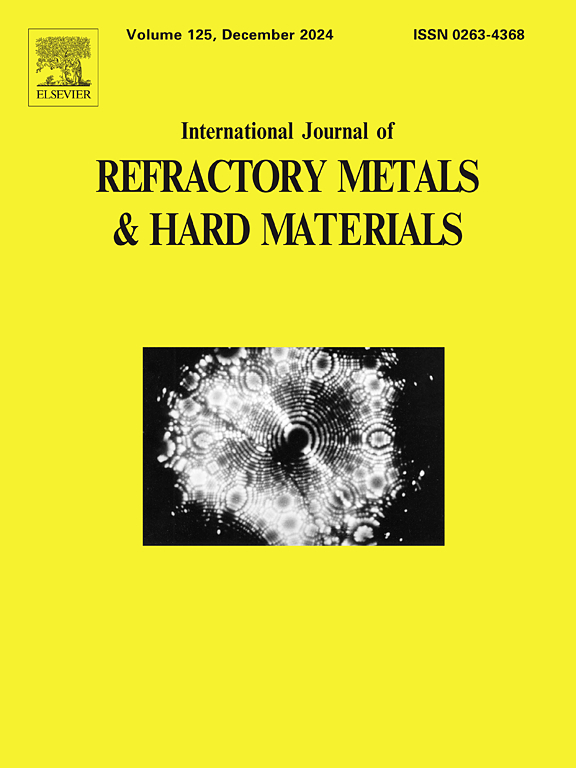Mechanisms of pore defects evolution in Mo14Re alloy welded joints under dislocation back stress
IF 4.2
2区 材料科学
Q2 MATERIALS SCIENCE, MULTIDISCIPLINARY
International Journal of Refractory Metals & Hard Materials
Pub Date : 2025-03-17
DOI:10.1016/j.ijrmhm.2025.107155
引用次数: 0
Abstract
Mo![]() 14Re alloy is widely utilized in aerospace and nuclear energy applications due to its exceptional high-temperature mechanical properties and radiation resistance. Despite its significant high-temperature stability, the presence of pore defects seriously damages the mechanical properties of the alloy. This study combines crystal plasticity finite element simulation to reveal the influence mechanism of dislocation back stress on pore defects in Mo
14Re alloy is widely utilized in aerospace and nuclear energy applications due to its exceptional high-temperature mechanical properties and radiation resistance. Despite its significant high-temperature stability, the presence of pore defects seriously damages the mechanical properties of the alloy. This study combines crystal plasticity finite element simulation to reveal the influence mechanism of dislocation back stress on pore defects in Mo![]() 14Re alloy welded joints. In the fusion zone (FZ), the formation of pore defects is primarily influenced by differences in Schmid factors, stress concentration, and dislocation motion. Grains with high Schmid factors are more prone to dislocation movement and significant deformation, while grains with low Schmid factors exhibit weaker deformability, leading to stress concentration at grain boundaries and suppressing dislocation motion around pores. This exacerbates local deformation inhomogeneity and promotes pore formation. In the weld zone (WZ), the formation of pore defects is closely related to stress concentration and dislocation motion. Stress concentration typically occurs at grain boundaries, triggering the generation and propagation of dislocations. This often results in uneven plastic deformation, leading to insufficient deformation in certain areas and the formation of pore defects. In the FZ, lower energy input restricts dislocation motion at subgrain boundaries, leading to stress concentration and back stress accumulation, which promotes pore defect formation. In contrast, the higher energy in the WZ increases dislocation strain energy, enabling dislocations to overcome subgrain boundaries more easily.
14Re alloy welded joints. In the fusion zone (FZ), the formation of pore defects is primarily influenced by differences in Schmid factors, stress concentration, and dislocation motion. Grains with high Schmid factors are more prone to dislocation movement and significant deformation, while grains with low Schmid factors exhibit weaker deformability, leading to stress concentration at grain boundaries and suppressing dislocation motion around pores. This exacerbates local deformation inhomogeneity and promotes pore formation. In the weld zone (WZ), the formation of pore defects is closely related to stress concentration and dislocation motion. Stress concentration typically occurs at grain boundaries, triggering the generation and propagation of dislocations. This often results in uneven plastic deformation, leading to insufficient deformation in certain areas and the formation of pore defects. In the FZ, lower energy input restricts dislocation motion at subgrain boundaries, leading to stress concentration and back stress accumulation, which promotes pore defect formation. In contrast, the higher energy in the WZ increases dislocation strain energy, enabling dislocations to overcome subgrain boundaries more easily.
位错背应力作用下Mo14Re合金焊接接头气孔缺陷演化机制
Mo14Re合金因其优异的高温机械性能和抗辐射性而广泛应用于航空航天和核能领域。尽管具有良好的高温稳定性,但孔隙缺陷的存在严重破坏了合金的力学性能。本研究结合晶体塑性有限元模拟,揭示位错背应力对Mo14Re合金焊接接头气孔缺陷的影响机理。在熔合区(FZ),气孔缺陷的形成主要受施密德因子、应力集中和位错运动差异的影响。高施密德因子的晶粒更容易发生位错运动,变形显著,而低施密德因子的晶粒变形能力较弱,导致晶界应力集中,抑制了孔隙周围的位错运动。这加剧了局部变形的不均匀性,促进了孔隙的形成。在焊缝区(WZ),气孔缺陷的形成与应力集中和位错运动密切相关。应力集中通常发生在晶界处,引发位错的产生和扩展。这往往造成塑性变形不均匀,导致某些区域变形不足,形成孔隙缺陷。在FZ区,较低的能量输入限制了亚晶界位错运动,导致应力集中和背应力积累,促进了孔隙缺陷的形成。相反,WZ中较高的能量增加了位错应变能,使位错更容易克服亚晶界。
本文章由计算机程序翻译,如有差异,请以英文原文为准。
求助全文
约1分钟内获得全文
求助全文
来源期刊
CiteScore
7.00
自引率
13.90%
发文量
236
审稿时长
35 days
期刊介绍:
The International Journal of Refractory Metals and Hard Materials (IJRMHM) publishes original research articles concerned with all aspects of refractory metals and hard materials. Refractory metals are defined as metals with melting points higher than 1800 °C. These are tungsten, molybdenum, chromium, tantalum, niobium, hafnium, and rhenium, as well as many compounds and alloys based thereupon. Hard materials that are included in the scope of this journal are defined as materials with hardness values higher than 1000 kg/mm2, primarily intended for applications as manufacturing tools or wear resistant components in mechanical systems. Thus they encompass carbides, nitrides and borides of metals, and related compounds. A special focus of this journal is put on the family of hardmetals, which is also known as cemented tungsten carbide, and cermets which are based on titanium carbide and carbonitrides with or without a metal binder. Ceramics and superhard materials including diamond and cubic boron nitride may also be accepted provided the subject material is presented as hard materials as defined above.

 求助内容:
求助内容: 应助结果提醒方式:
应助结果提醒方式:


